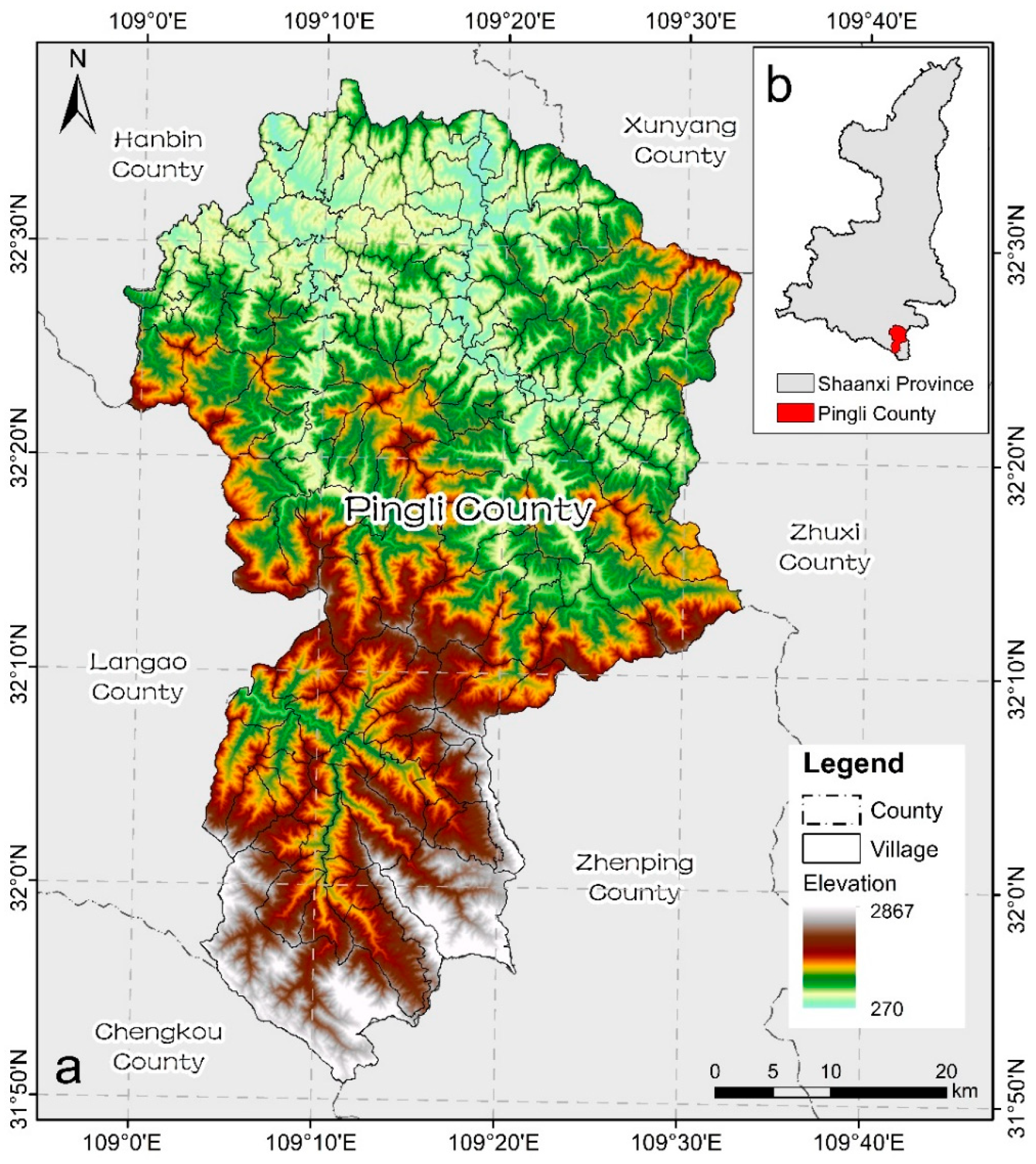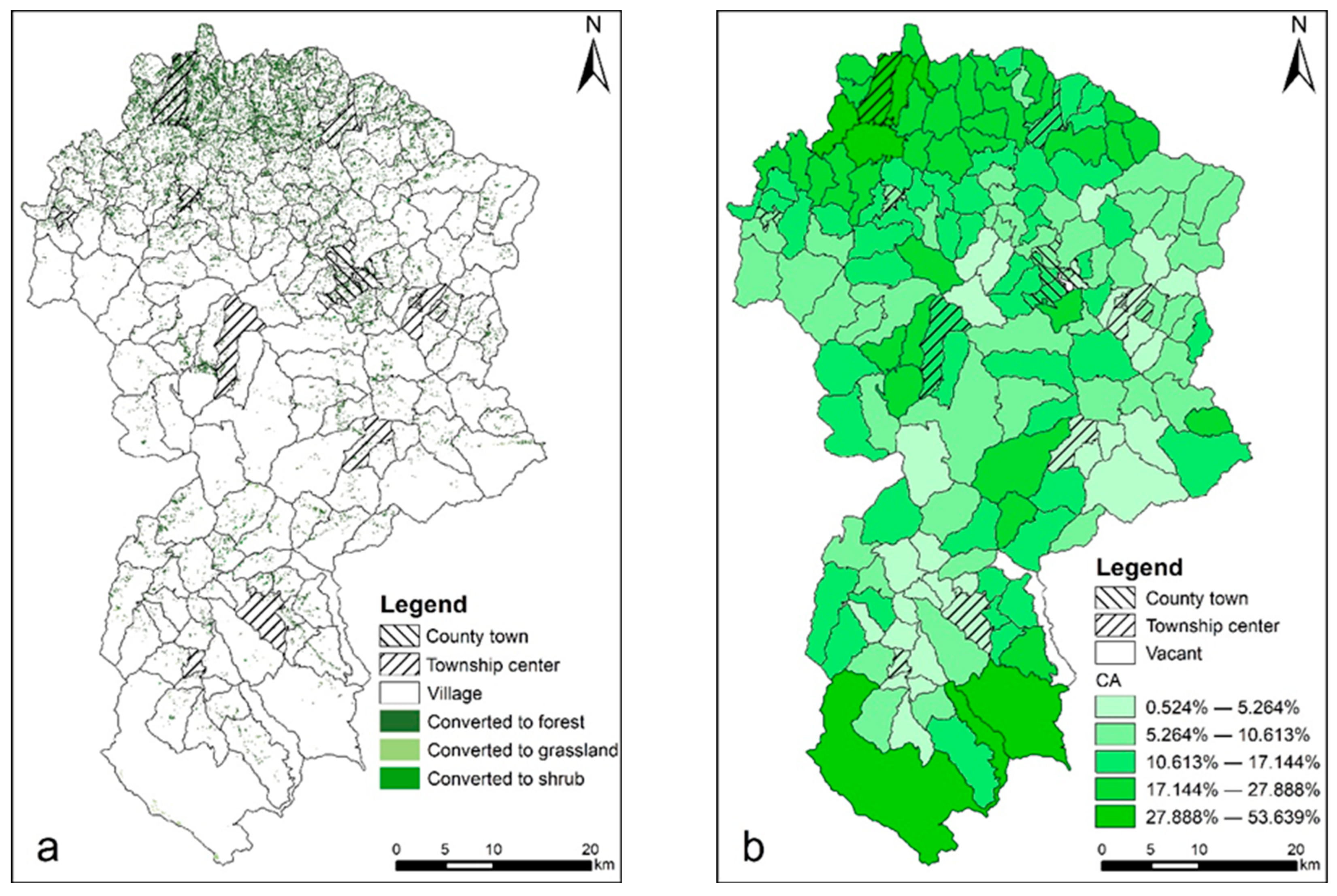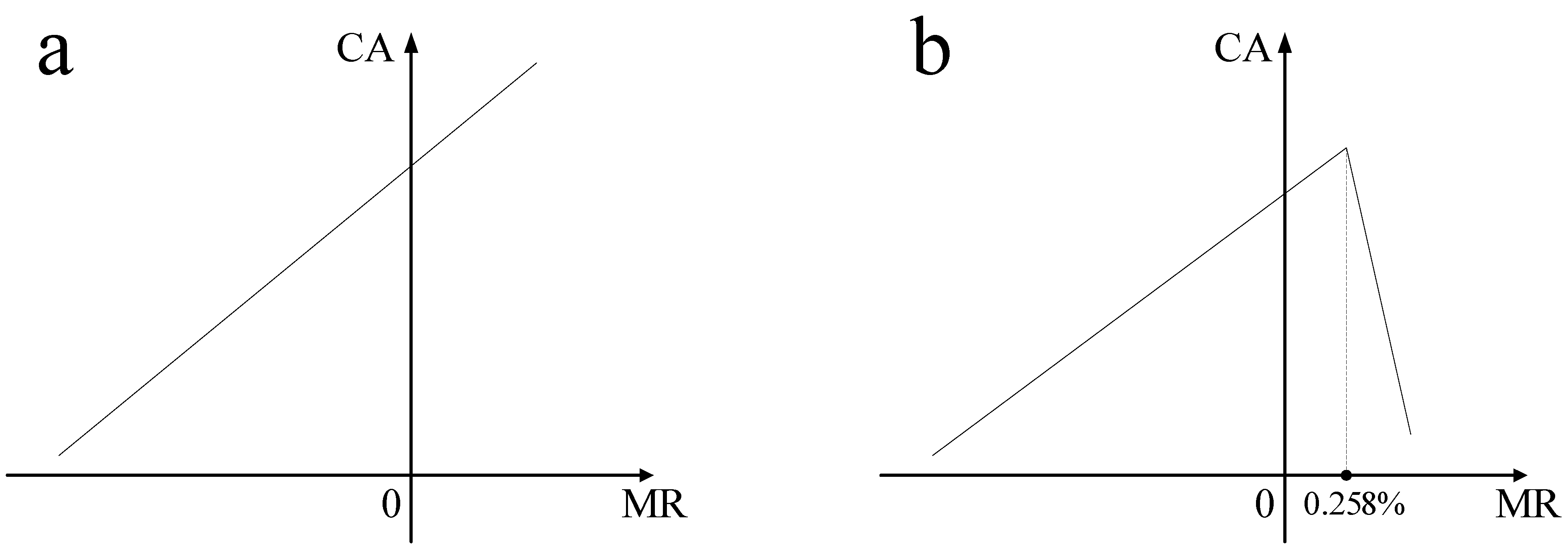Does a Migrant Relocation Program Aggravate Cropland Abandonment? A Case Study on Pingli County, China
Abstract
1. Introduction
2. The MR Program of Southern Shaanxi
3. Materials and Methods
3.1. Study Area
3.2. Data Source and Preprocessing
3.3. Variables Selection
3.3.1. Explained Variable
3.3.2. Core Explanatory Variable
3.3.3. Other Variables
- (1)
- Topographic factors
- (2)
- Climatic factors
- (3)
- Socioeconomic factors
- (4)
- Engineering measures
3.4. Econometric Model
3.4.1. Multiple Linear Regression Model
3.4.2. Threshold Regression Model
4. Results and Analysis
4.1. MR in Pingli County
4.2. CA in Pingli County
4.3. Results and Analysis of Econometric Model
5. Further Discussion
6. Conclusions and Implications
6.1. Main Finding
- Based on the relocation scale and resettlement scale, the MR programs in Pingli County were divided into three types: out-migration, in-migration, and vacant. Among them, out-migration was the main type, accounting for 67.98%. MR had a maximum value of 1.097% and a minimum value of −17.939%.
- From 2010 to 2020, the amount of CA in Pingli County added up to 35.910 km2. Of this, 35.553 km2 was converted into forest, accounting for 99.01%. The rest was converted into grassland and shrubland. The high CA values (CA > 17.144%) were concentrated in the northern hilly areas, while the lower CA values (CA < 10.613%) were concentrated around townships in the central and southern areas.
- The impact of MR on CA showed a nonlinear relationship. The threshold value was 0.258%. Specifically, when MR ≤ 0 or MR > 0.258%, MR had an inhibitory impact on CA; when 0 < MR ≤ 0.258%, MR promoted the occurrence of CA. Thus, it is not appropriate to assume that there is a linear relationship between MR and CA, and this will greatly affect the accuracy of policy evaluations. Compared with the multiple linear regression model, the threshold regression model was able to mine more useful information and is thus a powerful tool for policy evaluations.
- Although micro-scale studies such as household surveys can directly observe the actual behavioral changes of policy participants, especially land use behaviors, they ignore the mobility of cropland and policy integrity. In contrast, the result of macro-scale studies can provide a comprehensive understanding of policy effects. This also provides a new perspective for this research field.
6.2. Policy Implications
Author Contributions
Funding
Data Availability Statement
Conflicts of Interest
References
- Costanza, R.; d’Arge, R.; de Groot, R.; Farber, S.; Grasso, M.; Hannon, B.; Limburg, K.; Naeem, S.; O’Neill, R.V.; Paruelo, J.; et al. The value of the world’s ecosystem services and natural capital. Nature 1997, 387, 253–260. [Google Scholar] [CrossRef]
- Aide, T.M.; Grau, H.R. Ecology. Globalization, migration, and Latin American ecosystems. Science 2004, 305, 1915–1916. [Google Scholar] [CrossRef]
- Liu, W.; Li, J.; Xu, J. Impact of the ecological resettlement program in southern Shaanxi Province, China on households’ livelihood strategies. For. Policy Econ. 2020, 120, 102310. [Google Scholar] [CrossRef]
- Long, H.; Li, Y.; Liu, Y.; Woods, M.; Zou, J. Accelerated restructuring in rural China fueled by ‘increasing vs. decreasing balance’ land-use policy for dealing with hollowed villages. Land Use Policy 2012, 29, 11–22. [Google Scholar] [CrossRef]
- Dolton-Thornton, N. Rewilding and repeopling in Scotland: Large-scale land managers’ perspectives and practices. J. Rural. Stud. 2021, 86, 36–45. [Google Scholar] [CrossRef]
- Sluiter, R.; de Jong, S.M. Spatial patterns of Mediterranean land abandonment and related land cover transitions. Landsc. Ecol. 2007, 22, 559–576. [Google Scholar] [CrossRef]
- Lieskovský, J.; Bezák, P.; Špulerová, J.; Lieskovský, T.; Koleda, P.; Dobrovodská, M.; Bürgi, M.; Gimmi, U. The abandonment of traditional agricultural landscape in Slovakia—Analysis of extent and driving forces. J. Rural. Stud. 2015, 37, 75–84. [Google Scholar] [CrossRef]
- Han, Z.; Song, W. Abandoned cropland: Patterns and determinants within the Guangxi Karst Mountainous Area, China. Appl. Geogr. 2020, 122, 102245. [Google Scholar] [CrossRef]
- Li, S.; Li, X.; Sun, L.; Cao, G.; Fischer, G.; Tramberend, S. An estimation of the extent of cropland abandonment in mountainous regions of China. Land Degrad. Dev. 2018, 29, 1327–1342. [Google Scholar] [CrossRef]
- Milenov, P.; Vassilev, V.; Vassileva, A.; Radkov, R.; Samoungi, V.; Dimitrov, Z.; Vichev, N. Monitoring of the risk of farmland abandonment as an efficient tool to assess the environmental and socio-economic impact of the Common Agriculture Policy. Int. J. Appl. Earth Obs. Geoinf. 2014, 32, 218–227. [Google Scholar] [CrossRef]
- Yin, R.; Yin, G. China’s primary programs of terrestrial ecosystem restoration: Initiation, implementation, and challenges. Environ. Manag. 2010, 45, 429–441. [Google Scholar] [CrossRef]
- Shi, P.; Vanclay, F.; Yu, J. Post-Resettlement Support Policies, Psychological Factors, and Farmers’ Homestead Exit Intention and Behavior. Land 2022, 11, 237. [Google Scholar] [CrossRef]
- Zhang, W.; Zhou, L.; Zhang, Y.; Chen, Z.; Hu, F. Impacts of Ecological Migration on Land Use and Vegetation Restoration in Arid Zones. Land 2022, 11, 891. [Google Scholar] [CrossRef]
- Carter, M.R. Poverty traps and natural disasters in Ethiopia and Honduras. World Dev. 2007, 35, 835–856. [Google Scholar] [CrossRef]
- Barbier, E.B.; Hochard, J.P. Land degradation and poverty. Nat. Sustain. 2018, 1, 623–631. [Google Scholar] [CrossRef]
- Zhou, L.; Xiong, L.-Y. Natural topographic controls on the spatial distribution of poverty-stricken counties in China. Appl. Geogr. 2018, 90, 282–292. [Google Scholar] [CrossRef]
- Zhou, Y.; Li, Y.; Liu, Y. The nexus between regional eco-environmental degradation and rural impoverishment in China. Habitat Int. 2020, 96, 102086. [Google Scholar] [CrossRef]
- Taylor, J.E.; Lopez-Feldman, A. Does migration make rural households more productive? Evidence from Mexico. J. Dev. Stud. 2010, 46, 68–90. [Google Scholar] [CrossRef]
- Lo, K.; Xue, L.; Wang, M. Spatial restructuring through poverty alleviation resettlement in rural China. J. Rural. Stud. 2016, 47, 496–505. [Google Scholar] [CrossRef]
- Liu, Y.; Liu, J.; Zhou, Y. Spatio-temporal patterns of rural poverty in China and targeted poverty alleviation strategies. J. Rural. Stud. 2017, 52, 66–75. [Google Scholar] [CrossRef]
- Wang, W.; Ren, Q.; Yu, J. Impact of the ecological resettlement program on participating decision and poverty reduction in southern Shaanxi, China. For. Policy Econ. 2018, 95, 1–9. [Google Scholar] [CrossRef]
- Guo, X.; Kapucu, N. Examining the impacts of disaster resettlement from a livelihood perspective: A case study of Qinling Mountains, China. Disasters 2018, 42, 251–274. [Google Scholar] [CrossRef] [PubMed]
- Peng, W.; López-Carr, D.; Wu, C.; Wang, X.; Longcore, T. What factors influence the willingness of protected area communities to relocate? China’s ecological relocation policy for Dashanbao Protected Area. Sci. Total. Environ. 2020, 727, 138364. [Google Scholar] [CrossRef]
- Zhu, D.; Jia, Z.; Zhou, Z. Place attachment in the Ex-situ poverty alleviation relocation: Evidence from different poverty alleviation migrant communities in Guizhou Province, China. Sustain. Cities Soc. 2021, 75, 103355. [Google Scholar] [CrossRef]
- Liu, W.; Xu, J.; Li, J. The influence of poverty alleviation resettlement on rural household livelihood vulnerability in the western mountainous areas, China. Sustainability 2018, 10, 2793. [Google Scholar] [CrossRef]
- Gou, H.; Li, J. Impact of urban resettlement on the livelihood activities of rural resettled households in Southern Shaanxi Province with method of Coarsened Exact Matching (CEM). China Popul. Resour. Environ. 2019, 29, 149–156. (In Chinese) [Google Scholar]
- Tang, J.; Xu, Y.; Qiu, H. Integration of migrants in poverty alleviation resettlement to urban China. Cities 2022, 120, 103501. [Google Scholar] [CrossRef]
- Zhang, J.; Zhan, L.; Lu, C. The long-run effects of poverty alleviation resettlement on child development: Evidence from a quasi-experiment in China. Demogr. Res. 2020, 43, 245–284. [Google Scholar] [CrossRef]
- Fan, M.; Li, Y.; Li, W. Solving one problem by creating a bigger one: The consequences of ecological resettlement for grassland restoration and poverty alleviation in Northwestern China. Land Use Policy 2015, 42, 124–130. [Google Scholar] [CrossRef]
- Lemenih, M.; Kassa, H.; Kassie, G.T.; Abebaw, D.; Teka, W. Resettlement and woodland management problems and options: A case study from north-western Ethiopia. Land Degrad. Dev. 2014, 25, 305–318. [Google Scholar] [CrossRef]
- Wang, Q.; Qiu, J.J.; Yu, J. Does rural resettlement accelerate farmland abandonment in mountainous areas: A case study of 1578 households in Southern Shaanxi. J. Nat. Resour. 2019, 34, 1376–1390. (In Chinese) [Google Scholar]
- Artur, L.; Hilhorst, D. Floods, resettlement and land access and use in the lower Zambezi, Mozambique. Land Use Policy 2014, 36, 361–368. [Google Scholar] [CrossRef]
- Rye, J.F. Labour migrants and rural change: The “mobility transformation” of Hitra/Frøya, Norway, 2005–2015. J. Rural. Stud. 2018, 64, 189–199. [Google Scholar] [CrossRef]
- Gao, J.; Song, G.; Sun, X. Does labor migration affect rural land transfer? Evidence from China. Land Use Policy 2020, 99, 105096. [Google Scholar] [CrossRef]
- Wang, Y.; Li, X.; Xin, L.; Tan, M. Farmland marginalization and its drivers in mountainous areas of China. Sci. Total. Environ. 2020, 719, 135132. [Google Scholar] [CrossRef] [PubMed]
- Wang, J.; Cao, Y.; Fang, X.; Li, G. Does land tenure fragmentation aggravate farmland abandonment? Evidence from big survey data in rural China. J. Rural. Stud. 2022, 91, 126–135. [Google Scholar] [CrossRef]
- Guo, B.; Fang, Y.; Zhou, Y. Influencing factors and spatial differentiation of cultivated land abandonment at the household scale. Resour. Sci. 2020, 42, 696–709. (In Chinese) [Google Scholar] [CrossRef]
- Zhang, D.; Jia, Q.; Xu, X.; Yao, S.; Chen, H.; Hou, X. Contribution of ecological policies to vegetation restoration: A case study from Wuqi County in Shaanxi Province, China. Land Use Policy 2018, 73, 400–411. [Google Scholar] [CrossRef]
- Shaanxi Provincial People’s Government. Master Plan for Migrant Relocation and Resettlement in Southern Shaanxi (2011–2020); Internal Information; Shaanxi Provincial People’s Government: Xi’an, China, 2011. [Google Scholar]
- Yang, J.; Huang, X. The 30 m annual land cover dataset and its dynamics in China from 1990 to 2019. Earth Syst. Sci. Data 2021, 13, 3907–3925. [Google Scholar] [CrossRef]
- People’s Government of Pingli County. National Land Survey Report of Pingli County (2010-2020); Internal Information; People’s Government of Pingli County: Pingli, China, 2011.
- Levers, C.; Schneider, M.; Prishchepov, A.V.; Estel, S.; Kuemmerle, T. Spatial variation in determinants of agricultural land abandonment in Europe. Sci. Total. Environ. 2018, 644, 95–111. [Google Scholar] [CrossRef]
- Kuemmerle, T.; Hostert, P.; Radeloff, V.C.; van der Linden, S.; Perzanowski, K.; Kruhlov, I. Cross-border comparison of post-socialist farmland abandonment in the Carpathians. Ecosystems 2008, 11, 614–628. [Google Scholar] [CrossRef]
- Gellrich, M.; Zimmermann, N.E. Investigating the regional-scale pattern of agricultural land abandonment in the Swiss mountains: A spatial statistical modelling approach. Landsc. Urban Plan. 2007, 79, 65–76. [Google Scholar] [CrossRef]
- Xu, D.; Deng, X.; Guo, S.; Liu, S. Labor migration and farmland abandonment in rural China: Empirical results and policy implications. J. Environ. Manag. 2019, 232, 738–750. [Google Scholar] [CrossRef] [PubMed]
- Zhang, D.; Jia, Q.; Xu, X.; Yao, S.; Chen, H.; Hou, X.; Zhang, J.; Jin, G. Assessing the coordination of ecological and agricultural goals during ecological restoration efforts: A case study of Wuqi County, Northwest China. Land Use Policy 2019, 82, 550–562. [Google Scholar] [CrossRef]
- Shi, T.; Li, X.; Xin, L.; Xu, X. The spatial distribution of farmland abandonment and its influential factors at the township level: A case study in the mountainous area of China. Land Use Policy 2018, 70, 510–520. [Google Scholar] [CrossRef]
- Gellrich, M.; Baur, P.; Koch, B.; Zimmermann, N.E. Agricultural land abandonment and natural forest re-growth in the Swiss mountains: A spatially explicit economic analysis. Agric. Ecosyst. Environ. 2007, 118, 93–108. [Google Scholar] [CrossRef]
- Kolecka, N.; Kozak, J.; Kaim, D.; Dobosz, M.; Ostafin, K.; Ostapowicz, K.; Wężyk, P.; Price, B. Understanding farmland abandonment in the Polish Carpathians. Appl. Geogr. 2017, 88, 62–72. [Google Scholar] [CrossRef]
- Liu, H.; Cui, W.; Zhang, M. Exploring the causal relationship between urbanization and air pollution: Evidence from China. Sustain. Cities Soc. 2022, 80, 103783. [Google Scholar] [CrossRef]
- Tong, H.; Lim, K.S. Threshold autoregression, limit cycles and cyclical data. J. R. Stat. Soc. Ser. B (Stat. Methodol.) 1980, 42, 245–268. [Google Scholar] [CrossRef]
- Hou, X.; Liu, J.; Zhang, D.; Zhao, M.; Xia, C. Impact of urbanization on the eco-efficiency of cultivated land utilization: A case study on the Yangtze River Economic Belt, China. J. Clean. Prod. 2019, 238, 117916. [Google Scholar] [CrossRef]
- Xu, F.; Wang, Z.; Chi, G.; Zhang, Z. The impacts of population and agglomeration development on land use intensity: New evidence behind urbanization in China. Land Use Policy 2020, 95, 104639. [Google Scholar] [CrossRef]
- Hansen, B.E. Sample Splitting and Threshold Estimation. Econometrica 2000, 68, 575–603. [Google Scholar] [CrossRef]
- Caner, M.; Hansen, B.E. Threshold autoregression with a unit root. Econometrica 2001, 69, 1555–1596. [Google Scholar] [CrossRef]
- Franco, W.; Barbera, F.; Bartolucci, L.; Felizia, T.; Focanti, F. Developing intermediate machines for high-land agriculture. Dev. Eng. 2020, 5, 100050. [Google Scholar] [CrossRef]
- Rigg, J. Land, farming, livelihoods, and poverty: Rethinking the links in the Rural South. World Dev. 2006, 34, 180–202. [Google Scholar] [CrossRef]
- Zhang, Y.; Li, X.; Song, W.; Zhai, L. Land abandonment under rural restructuring in China explained from a cost-benefit perspective. J. Rural. Stud. 2016, 47, 524–532. [Google Scholar] [CrossRef]
- Zhao, X.; Xiao, J.Q.; Duan, Y.F. Relocation, farmland transfer and livelihood transformation of reservoir resettlement. Resour. Sci. 2018, 40, 1954–1965. (In Chinese) [Google Scholar]
- Yang, C.; Qian, Z. ‘Resettlement with Chinese characteristics’: The distinctive political-economic context, (in) voluntary urbanites, and three types of mismatch. Int. J. Urban Sustain. Dev. 2021, 13, 496–515. [Google Scholar] [CrossRef]




| Relocation (RL) | Population | Resettlement (RS) | Population |
|---|---|---|---|
| Poverty alleviation RL | 1,166,071 | New village RS | 1,543,794 |
| Geological disaster avoidance RL | 491,594 | County town or township RS | 440,989 |
| Flood disaster avoidance RL | 320,185 | Small village merging into large village RS | 257,009 |
| Ecological RL | 468,838 | Self-determined RS | 206,516 |
| Engineering RL | 1620 |
| Classification | Criterion Layer | Variables | Min | Max | Mean | Std. |
|---|---|---|---|---|---|---|
| Dependent Variable | CA (%) | 0.524 | 53.639 | 12.716 | 0.086 | |
| Independent Variables | Core Variable | MR (%) | −17.939 | 1.097 | −0.194 | 0.017 |
| Topographic factors | Slope (degree) | 6.573 | 30.123 | 18.392 | 4.330 | |
| Elevation (m) | 324.354 | 2337.738 | 751.160 | 315.674 | ||
| Climatic factors | Precipitation (mm) | 870.667 | 1059.599 | 962.658 | 42.338 | |
| Temperature (℃) | 4.457 | 14.624 | 11.805 | 2.258 | ||
| Socioeconomic factors | PCR (-) | 2.599 | 67.595 | 11.042 | 7.803 | |
| RD (km−1) | 0.140 | 4.277 | 1.143 | 0.679 | ||
| Engineering measures | EM (%) | 0.000 | 87.565 | 18.252 | 0.119 |
| Variables | Multiple Regression Model | Threshold Regression Model | |||||
|---|---|---|---|---|---|---|---|
| MR ≤ 0.258% | MR > 0.258% | ||||||
| Coefficient | R.S.E. | VIF | Coefficient | R.S.E. | Coefficient | R.S.E. | |
| MR | 1.144 *** | 0.331 | 1.41 | 1.293 *** | 0.304 | −6.190 * | 3.343 |
| Slope | −0.004 ** | 0.002 | 1.44 | −0.004 ** | 0.002 | −0.002 | 0.003 |
| Elevation | 0.001 *** | 0.000 | 3.20 | 0.001 *** | 0.000 | 0.001 ** | 0.000 |
| Precipitation | −0.002 *** | 0.000 | 3.04 | −0.002 *** | 0.000 | −0.002 *** | 0.000 |
| PCR | 0.002 * | 0.001 | 1.29 | 0.001 | 0.001 | 0.002 | 0.002 |
| RD | 0.018 ** | 0.009 | 1.58 | 0.047 *** | 0.009 | −0.019 | 0.014 |
| EM | 0.030 | 0.048 | 1.20 | 0.074 | 0.064 | −0.059 | 0.062 |
| (Constant) | 1.519 *** | 0.224 | - | 1.290 *** | 0.248 | 1.865 *** | 0.332 |
| Observations | 176 | 106 | 70 | ||||
| F-Value | 15.530 | 12.270 | 10.140 | ||||
| R2 | 0.453 | 0.561 | 0.513 | ||||
| H0 | Threshold Variable | LM-Value | p-Value | Threshold-Value |
|---|---|---|---|---|
| No threshold | MR | 21.452 | 0.028 | 0.258% |
Disclaimer/Publisher’s Note: The statements, opinions and data contained in all publications are solely those of the individual author(s) and contributor(s) and not of MDPI and/or the editor(s). MDPI and/or the editor(s) disclaim responsibility for any injury to people or property resulting from any ideas, methods, instructions or products referred to in the content. |
© 2025 by the authors. Licensee MDPI, Basel, Switzerland. This article is an open access article distributed under the terms and conditions of the Creative Commons Attribution (CC BY) license (https://creativecommons.org/licenses/by/4.0/).
Share and Cite
Liu, J.; Zhou, X.; Hou, X. Does a Migrant Relocation Program Aggravate Cropland Abandonment? A Case Study on Pingli County, China. Land 2025, 14, 518. https://doi.org/10.3390/land14030518
Liu J, Zhou X, Hou X. Does a Migrant Relocation Program Aggravate Cropland Abandonment? A Case Study on Pingli County, China. Land. 2025; 14(3):518. https://doi.org/10.3390/land14030518
Chicago/Turabian StyleLiu, Jingming, Xin Zhou, and Xianhui Hou. 2025. "Does a Migrant Relocation Program Aggravate Cropland Abandonment? A Case Study on Pingli County, China" Land 14, no. 3: 518. https://doi.org/10.3390/land14030518
APA StyleLiu, J., Zhou, X., & Hou, X. (2025). Does a Migrant Relocation Program Aggravate Cropland Abandonment? A Case Study on Pingli County, China. Land, 14(3), 518. https://doi.org/10.3390/land14030518







